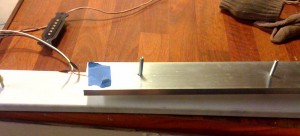 This weekend’s work has been mostly about sound (with a little van tinkering here and there).
This weekend’s work has been mostly about sound (with a little van tinkering here and there).
How do we amplify two full keyboards of two and a half octaves of keys each, order plus numerous gongs and chimes?
Full-court press – set up a testing environment, salve bring in some mikes and amps, this web and sort it out, right?
We picked up a little mixing board at Guitar Center on Saturday night and spent some time bullshitting with the staff about microphones.
The challenge of the project is getting a full, clean mix out of the instrument in the face of these facts:
- the high keys are very faint compared with the low ones
- ambient noise will be a challenge, particularly on the playa
- We want to get enough sound out of the system to reach across the playa without causing feedback through the pickups
- The instruments will be bolted to the van full-time, so the miking solution must be removable to avoid the worst of the weather …
They suggested drum mikes or area mikes of some kind – cardiod condensers maybe? So, I invited Brian over to consult in the evening, and asked him to bring a condenser with him.
Meanwhile, alienrobot and I set about finding amplification. With the mixer handling the pre-amp/head-unit duties, all that was needed was a big, deep-cycle auxiliary 12-volt marine battery pushing a big, dumb amp.
 We got the battery at Pep Boys and headed to the L.A. City College swap meet – a good source for used (hot?) car sound equipment.
We got the battery at Pep Boys and headed to the L.A. City College swap meet – a good source for used (hot?) car sound equipment.
There, we buy a big, heavy amp – the size of a phone book and three times the weight – for $40 and run home to check it out. RCA the mixer to the amp, wire up a pair of old speakers, clamp beefy power cables to the marine battery and …
It’s dead. No lights, no sound, nothing. We head back to the swap meet. The guy’s very cheerful about returning my money – I figure he just got a bad unit from wherever – and I buy a smaller but in-better-shape unit for $30, and head back – and it’s busted too.
Grrr.
I borrow alienrobot’s amplifier (one of my old hand-me-downs) and set that up – and it works fine with our sound-test machine, the Kaossilator – lots of nice reverb from the mixer – this will sound great if we can get the microphones figured out.
I start with a guitar pickup I got on eBay for about five bucks – of course it won’t hear the keys because they’re not magnetic. I try hot-gluing a bit of guitar string to the end of a key, and holding the pickup next to it. But the pickup barely does its job – and in fact works beautifully with the three small steel-disc chimes instead:
Next, I try a cheap little piezo transducer mike, taped directly to a key.
 It’s designed to be stuck to the body of a guitar or ukulele, so it senses direct pressure – and resonated quite well in the sound check:
It’s designed to be stuck to the body of a guitar or ukulele, so it senses direct pressure – and resonated quite well in the sound check:
The buzzing you hear is metal key on metal mounting bolt, minus any damping – (I’ll put rubber o-rings there later for insulation) but the tone is rich, full and bang-on.
Couple of problems: I would have to somehow permanently attach these to nearly 60 keys, and they are virtually impossible to weatherproof – plus, they heavily damp the key’s ability to resonate, which means shorter, duller notes.
So, back to the drawing board.
Brian comes over for a bit, and we try the condenser mike – but proves to be too weak to grab the note from even a single key without cranking the amp up into feedback territory.
So, we spend some time talking about the next experiment – resonators (maybe a box or some tubes hung from beneath the keys, as in a vibraphone) and area mikes. This seems a lot more promising and portable (just unclip the resonator assembly from the xylophone, for transport)
Anyway, we’re figuring it out, so stay tuned.
And no, that was a cliché, not a pun.
